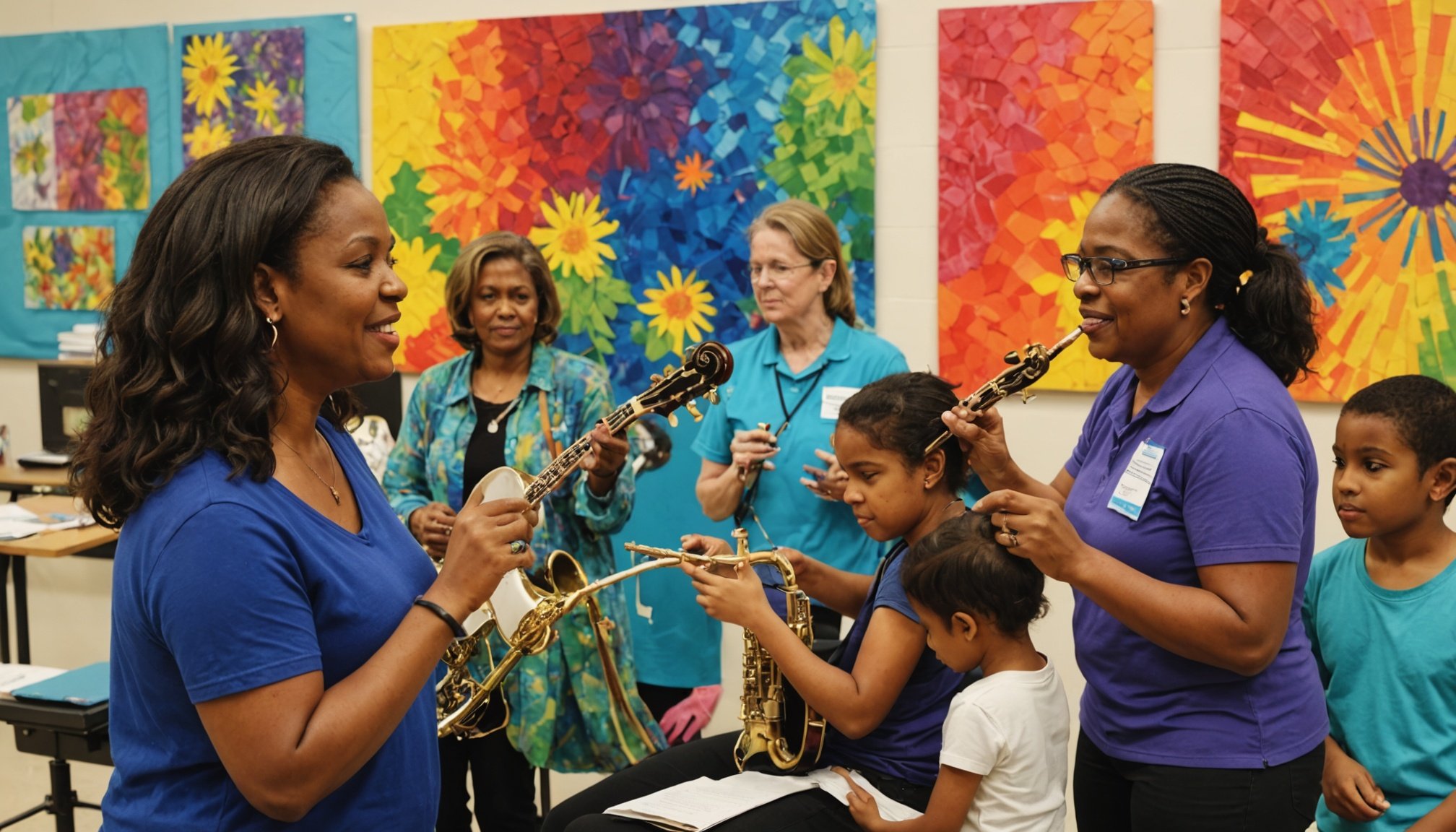Unlocking Well-Being: How Community Arts Programs Boost Mental Health
In the pursuit of overall well-being, the role of community arts programs has emerged as a significant and multifaceted tool. These programs, which encompass a wide range of creative activities, are not just hobbies or pastimes but have been proven to have profound effects on both mental and physical health. Here, we delve into the world of community arts, exploring how these programs can transform lives and foster a healthier, more connected community.
The Power of Creative Expression
Creative expression is at the heart of community arts programs. Whether it’s painting, singing, dancing, or any other form of artistic activity, these programs provide a platform for people to express themselves in ways that transcend verbal communication.
Additional reading : Boost Your B12: How Nutritional Yeast Enhances Vegan Diets Daily
“From visiting museums and galleries to participating in choirs and watching theatre performances, these activities enrich our lives in countless ways,” notes Gus O’Donnell in a recent study on the health benefits of cultural engagement[1].
Art therapy, a specific form of creative expression, has been extensively studied for its mental health benefits. It can promote self-expression, self-exploration, emotional release, increased self-esteem, stress relief, and the development of positive coping skills[2].
Also to discover : Effective Diet Tips to Ease Rheumatoid Arthritis Symptoms
Mental Health Benefits of Community Arts
The mental health benefits of engaging in community arts programs are numerous and well-documented.
Reducing Anxiety and Depression
Community arts programs have been shown to significantly reduce symptoms of anxiety and depression. By providing a creative outlet, these programs help individuals process their emotions and achieve a state of relaxation and positive emotional well-being[4].
Improving Self-Esteem
Engaging in creative activities can boost self-esteem, particularly in children and older adults. For example, singing in choirs has been found to improve the health of older adults by enhancing their sense of purpose and social connection[1].
Managing Stress
Art therapy and other creative activities can activate the brain’s reward system, promoting relaxation and reducing levels of cortisol, a stress hormone. This “flow” state, as it is often called, allows individuals to focus fully on the creative process, temporarily forgetting about their stressors[2].
Addressing Trauma
For individuals who have experienced trauma, community arts programs can provide a safe and controlled environment to process their emotions. The creative process helps in reducing symptoms such as flashbacks and nightmares associated with post-traumatic stress disorder (PTSD)[4].
Physical Health Benefits
While the mental health benefits are well-known, community arts programs also have significant physical health advantages.
Reducing Frailty and Physical Decline
Engaging in arts activities can maintain physical functioning, reducing frailty and age-related physical decline. This is particularly beneficial for older adults, who can experience improved mobility and coordination through activities like dance or movement therapy[1].
Enhancing Fine Motor Skills
Creative activities such as painting, drawing, or sculpting can help develop and maintain fine motor skills. When combined with physical therapy, these activities can enhance the healing process by encouraging movement and boosting motivation[4].
Social Benefits of Community Arts
Community arts programs are not just about individual well-being; they also foster a sense of community and social connection.
Building Social Connections
Participating in group arts activities, such as choir singing or community theater, helps individuals build and maintain social connections. This social support is crucial for mental health, as it reduces feelings of loneliness and isolation[1].
Promoting Community Engagement
Community arts programs often involve collaborative projects that bring people together. These projects can range from public art installations to community festivals, all of which promote a sense of community and shared purpose[5].
How to Get Involved in Community Arts Programs
Getting involved in community arts programs is easier than you might think. Here are some steps and tips to help you get started:
Finding Local Programs
- Look for local community centers, libraries, or churches that often host arts programs.
- Check online for groups or organizations in your area that offer art therapy or creative activities.
- Ask friends, family, or healthcare providers for recommendations.
Online Resources
- Many organizations offer online art therapy sessions or creative activities. This can be especially helpful for those with mobility issues or living in remote areas[2].
Starting Small
- Begin with simple activities like drawing, journaling, or even doodling.
- Join a local art class or workshop to explore different mediums and find what you enjoy most.
Practical Insights and Actionable Advice
Here are some practical insights and actionable advice to help you make the most out of community arts programs:
Embrace Creativity Without Judgment
- Remember that the creative process is more important than the end product. Don’t worry about your skill level; focus on the joy and therapeutic benefits of creating[2].
Make It a Habit
- Incorporate creative activities into your routine, whether it’s weekly art classes or daily journaling. Consistency is key to experiencing the full benefits of these programs.
Seek Professional Guidance
- If you’re struggling with mental health issues, consider working with a licensed art therapist. They can tailor the creative process to your specific needs and goals[3].
Real-Life Examples and Anecdotes
To illustrate the impact of community arts programs, let’s look at a few real-life examples:
The Choir Effect
A study found that older adults who participated in choir singing experienced significant improvements in their mental and physical health. This included better cognitive function, reduced symptoms of depression, and improved social connections[1].
Art Therapy in Schools
In some schools, art therapy is integrated into the curriculum to help children manage stress and improve their self-esteem. This approach has shown promising results in reducing behavioral issues and improving academic performance[4].
Comparative Table: Traditional Therapy vs. Art Therapy
Here is a comparative table highlighting the differences and similarities between traditional therapy and art therapy:
| Aspect | Traditional Therapy | Art Therapy |
|---|---|---|
| Method | Verbal communication | Non-verbal expression through art |
| Focus | Cognitive and behavioral changes | Emotional expression and self-exploration |
| Settings | Individual or group sessions | Individual, group, or community settings |
| Tools | Talk therapy, cognitive-behavioral techniques | Painting, drawing, sculpting, music, dance |
| Benefits | Reduces symptoms of mental health disorders | Reduces anxiety, depression; improves self-esteem; enhances cognitive function |
| Therapist Role | Guides verbal communication and cognitive restructuring | Facilitates creative process; interprets artistic expressions |
| Client Involvement | Active participation in discussions | Active engagement in creative activities |
Detailed List of Benefits
Here is a detailed list of the benefits associated with community arts programs and art therapy:
- Emotional Release: Provides a healthy outlet to express and work through difficult emotions.
- Self-Exploration: Allows individuals to explore feelings or themes that may be tricky to express in words.
- Improved Self-Esteem: Develops renewed confidence through the discovery of new abilities.
- Stress Relief: Activates the brain’s reward system, reducing levels of cortisol and promoting relaxation.
- Social Connections: Builds and maintains social connections, reducing feelings of loneliness.
- Physical Health Benefits: Maintains physical functioning, reduces frailty, and enhances fine motor skills.
- Trauma Processing: Helps individuals process and heal from traumatic experiences.
- Cognitive Development: Supports cognitive development and protects against cognitive decline.
- Community Engagement: Promotes community engagement and a sense of shared purpose.
Quotes and Insights from Experts
“Having studies confirm not only the physical and mental benefits that come with participating but also the specific monetary benefit to health costs might just get some attention or at least add to the arguments,” says Santa Aloi, professor emerita of dance at SFU, highlighting the importance of research in validating the benefits of arts programs[1].
“Art therapy can be a powerful intervention that helps individuals overcome the limitations of language,” notes Paige Schanbacher, MFT-intern, emphasizing the unique value of art therapy in mental health treatment[5].
Community arts programs and art therapy are more than just creative hobbies; they are powerful tools for improving mental and physical health. By providing a platform for self-expression, social connection, and emotional release, these programs can transform lives and foster a healthier, more connected community. Whether you’re looking to manage stress, improve your self-esteem, or simply find a new way to express yourself, community arts programs offer a wealth of benefits that are worth exploring.
So, why not give it a try? Join a local art class, participate in a community choir, or simply start doodling. The world of community arts is waiting to unlock your well-being and creativity.






